-
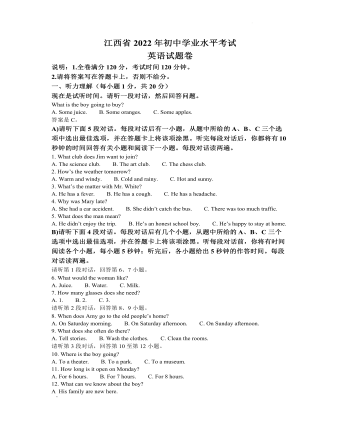
2022年江西省中考英语真题(原卷版)
Long ago, a poor old couple lived on the coast.One day, an old storyteller came to their village. The old couple gave him ameal. In return, he gave them a coffee mill (磨粉机)and said, “Say, ‘Mill, please grind (磨粉)’,”
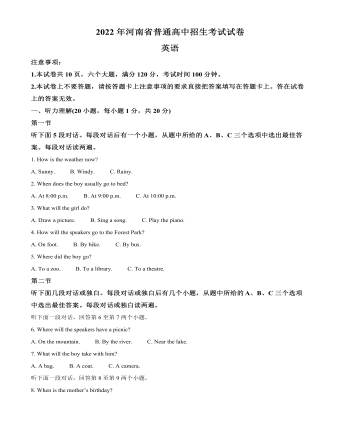
2022年河南省中考英语真题(解析版)
In the large yard stood thirteen trees ofdifferent sizes. One day, while Joey was playing with his sister under thetrees, he noticed that a tree trunk (树干) had a sad look. He raninto the house to tell his mom about it. She told Joey to find the reason whyit was sad.
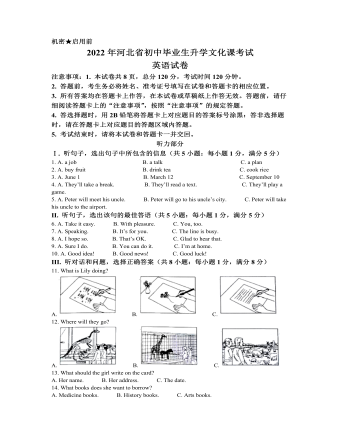
2022年河北省中考英语真题(解析版)
As a boy, Kevin visited national parks and helearned the Earth is in ___12___condition. He felt worried, and he wanted to ___13___ the Earth. In 2009, he went to swim in waternear North Pole(北极)todraw people’s attention to the melting glaciers(融化的冰川).
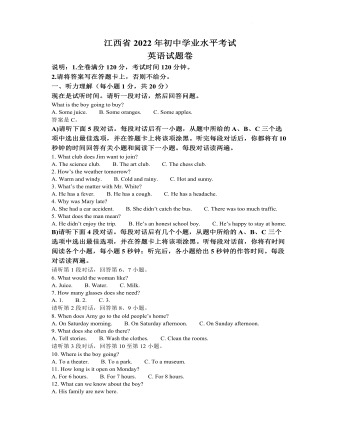
2022年江西省中考英语真题(解析版)
The app — called Sit With Us — is ___15___. If a student is having lunch in the afternoon,he or she can create an invitation. Other students can open the app and ___16___ that invitation. They can then use the app todecide when and where to ___17___.

2022年福建省中考英语真题(原卷版)
Thinking that her dream could never come true,Kelly was in low spirits and ____18____ her studies at school. Hermother did all she could to cheer her up, ____19____ Kelly refused tochange. She even took out all her anger and ____20____ on her mother.
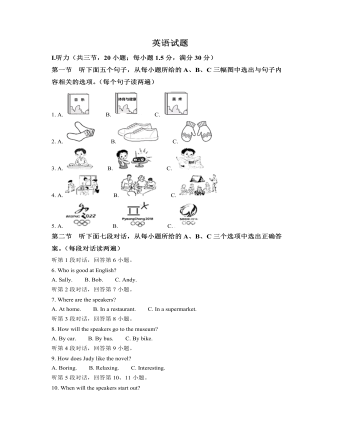
2022年福建省中考英语真题(解析版)
At the age of nine, Kelly dreamed of being abasketball player. But one day when she was playing basketball, she hurt herleft leg ____16____.
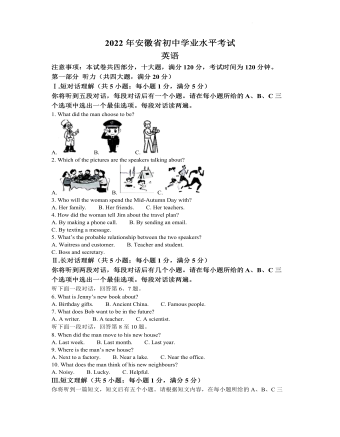
2022年安徽省中考英语真题(解析版)
Antarctica lies in the most southern part of theworld. It is the coldest area on Earth. There isn’t much rain, but there is alot of snow and wind. The lowest temperature was on 21 July in 1983 at -89.2℃!
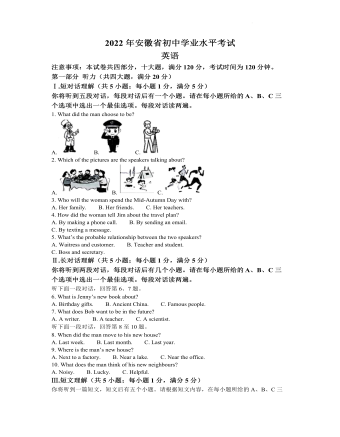
2022年安徽省中考英语真题(原卷版)
During 1907-1909, British explorer EarnestShackleton explored Antarctica on foot. In 1911, two explorers—a British mannamed Scott and a Norwegian named Amundsen—raced 1, 400 kilometres to the SouthPole (南极).Amundsen arrived first.
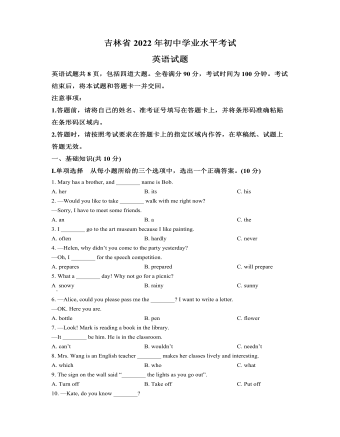
2022年吉林省中考英语真题(原卷版)
Taiping nijiaojiao is made of the mudfrom the local mountain. It takes more than ten steps to make the clay toy, andthe key step is to knead (捏) it with your hands. You can knead the clay toyinto anything, like animals and plants. The blowhole is the most difficult partto make, for the size of the blowhole makes a difference to the sound. Whilecoloring, you can use traditional cultural elements (元素) thatcarry good meanings. It’s hard to make taipingnijiaojiao. But when you finally make it, you will feel proud of yourself.
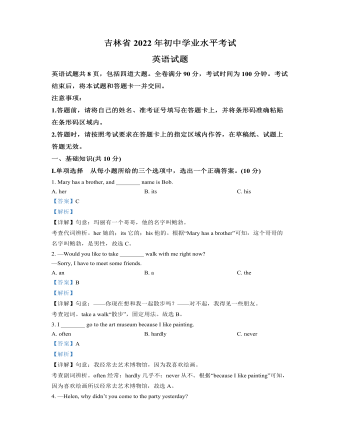
2022年吉林省中考英语真题(解析版)
“Red Trip” in TonghuaTonghua is a good choice to have a “red trip”. It is aplace full of “red stories”. The well-known national hero Yang Jingyu oncefought here. Experience the “red spirit”!
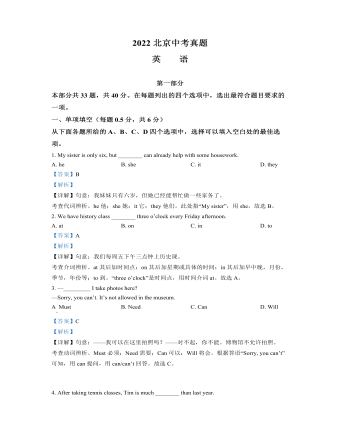
2022年北京市中考英语真题(解析版)
I joineda band (乐队)as a drummer in my middle school. I thought itwould be fun playing the drum and meeting new friends. At first it was easy,but a month later, it got difficult. I was the only one who couldn’t keep pace (节奏)with the other players. Our teacher,Angie, singled me out to keep practicing while everyone else got to relax. Ifelt ashamed (羞愧的)as my teammates watched me fail so many times.Finally I got so tired of practicing that I didn’t care about doing it right.
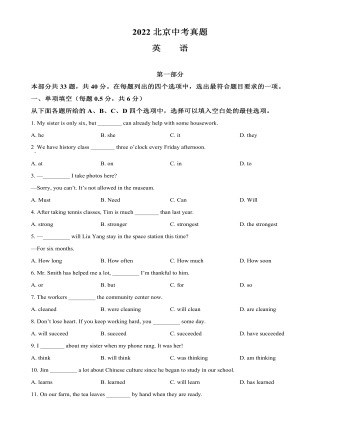
2022年北京市中考英语真题(原卷版)
When itcomes to a meaningful life, we might think of love, happiness and health. Alife filled with meaning is what most of us want for ourselves. Then, whatmakes a meaningful life?Manyresearchers agree that a meaningful life comes down to three factors (因素): havinglong-term goals, believing that one’s life matters, and feeling that one’s lifefits together and “makes sense”.But we believe there is more to consider. Sometimeslife enables us to experience small moments of beauty. When people are open toappreciating (欣赏) suchexperiences, these moments may improve how they see their own life. We callthis experiential appreciation (EA).
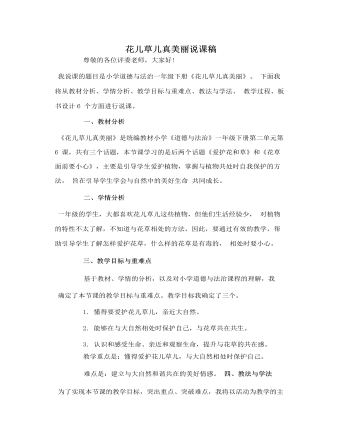
人教部编版道德与法制一年级下册花儿草儿真美丽说课稿
活动二:花草面前要小心 学生谈一谈自己曾经遇到过的或听说过的因与植物接触而受伤的事情,教师引导学生学会与植物共处时自我保护的方法。(板书: 保护自我)设计意图: 掌握与植物共处时自我保护的方法,学会与自然中的 美好生命共同生长。活动三:与花儿草儿共在课件出示儿歌《玫瑰花》。学生先自己读一读,再全班一起读。设计意图:再次感受美丽而神秘的植物世界。 环节三:课堂小结,内化提升 学生谈一谈学习本节课的收获,教师相机引导。设计意图:梳理总结,体验收获与成功的喜悦,内化提升学生的 认识与情感。环节四:回归生活,拓展延伸 回家后,学着种些花和草。设计意图: 将课堂所学延伸到学生的日常生活中,有利于落实行 为实践。六、板书设计为了突出重点, 让学生整体上感知本节课的主要内容, 我将以思 维导图的形式设计板书:

小班数学教案:蝴蝶找花 (认识颜色)
2、教幼儿学习把相同颜色的不同物体放在一起。 3、激发幼儿参与活动的兴趣,培养幼儿讲述操作过程的习惯。 活动准备: 1、红、黄、绿色的小房子(纸盒做的)各一个,幼儿每人一篮(3—6片)红、黄、绿色雪花片。 2、红、黄、绿色花一朵,红、黄、绿色蝴蝶卡片各一个。 活动过程: 1、蝴蝶找花(把相同颜色的物体放在一起)。 教师出示红、黄、绿色花卡片和红、黄、绿色蝴蝶卡片各一个,讲述小故事,“花园里住着三只美丽的蝴蝶,一只是红色的(舞动红蝴蝶),一只是黄色的(舞动黄蝴蝶),还有一只是绿色的(舞动绿蝴蝶)。它们天天在花园里唱歌、跳舞、做游戏,非常快乐。有一天,三只蝴蝶正在花园里玩‘捉迷藏’的游戏,忽然‘哗啦拉’下起雨来,三只蝴蝶想在花姐姐的叶子下面避雨,花姐姐说:‘和我颜色一样的蝴蝶请进来吧!’谁愿意帮助三只蝴蝶找到相同颜色的花?” 2、游戏“蝴蝶找花”

小班数学教案:串串香(按规律排列)
1、初步尝试按交替规律排列物体,并能边操作边讲述:一个╳╳,一个╳╳。 2、通过观察范例和教师语言的引导,能发现实物交替排列的规律。 3、乐意制作串串香,感知体验制作成功的快乐。 活动准备 教具:用橡皮泥捏的黄瓜、香蕉、冬枣、圣女果等,按交替规律串成两串“串串香。 学具: ——橡皮泥做的水果若干,长竹签若干根,彩色木珠若干。 ——幼儿用书,彩色笔。
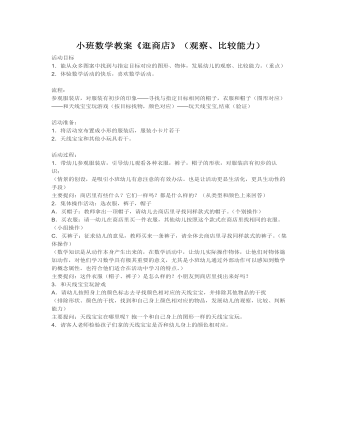
小班数学教案《逛商店》(观察、比较能力)
2.体验数学活动的快乐,喜欢数学活动。流程: 参观服装店,对服装有初步的印象——寻找与指定目标相同的帽子,衣服和帽子(图形对应)——和天线宝宝玩游戏(按目标找物,颜色对应)——玩天线宝宝,结束(验证) 活动准备: 1.将活动室布置成小形的服装店,服装小卡片若干 2.天线宝宝和其他小玩具若干。 活动过程: 1.带幼儿参观服装店,引导幼儿观看各种衣服,裤子,帽子的形状,对服装店有初步的认识; (情景的创设,是吸引小班幼儿有意注意的有效办法。也是让活动更显生活化,更具生动性的手段) 主要提问:商店里有些什么?它们一样吗?都是什么样的?(从类型和颜色上来回答)

小班数学教案:蝴蝶找花 (认识颜色) (2)
2、巩固按物体的数量匹配相应的点卡。 3、在教师的引导下,理解活动操作过程,能正确地进行操作。 活动准备: 水果实物(苹果1个、橘子2个、梨子3个),单独的动物图片(每种动物数量分别是1、2、3),1—3的点卡,盘子3个,大分类箩筐1个。 活动过程: 一、妈妈买的水果。 1、教师(出示一篮水果):这是妈妈刚才买回来的水果,请你帮助妈妈一起来整理水果好吗? 2、师幼将水果拿出来放在桌子上说一说:有哪些水果? 3、启发幼儿思考:我们怎样整理它们呢?引导幼儿把一样的水果放在一个盘子
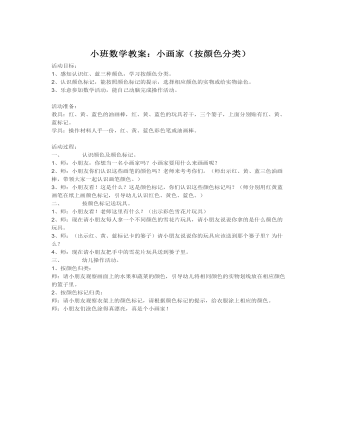
小班数学教案:小画家(按颜色分类)
2、认识颜色标记,能按照颜色标记的提示,选择相应颜色的实物或给实物涂色。 3、乐意参加数学活动,能自己动脑完成操作活动。 活动准备: 教具:红、黄、蓝色的油画棒,红、黄、蓝色的玩具若干,三个篓子,上面分别贴有红、黄、蓝标记。 学具:操作材料人手一份,红、黄、蓝色彩色笔或油画棒。 活动过程: 一、 认识颜色及颜色标记。 1、师:小朋友,你想当一名小画家吗?小画家要用什么来画画呢? 2、师:小朋友你们认识这些画笔的颜色吗?老师来考考你们。(师出示红、黄、蓝三色油画棒,带领大家一起认识画笔颜色。) 3、师:小朋友看!这是什么?这是颜色标记,你们认识这些颜色标记吗?(师分别用红黄蓝画笔在纸上画颜色标记,引导幼儿认识红色、黄色、蓝色。)
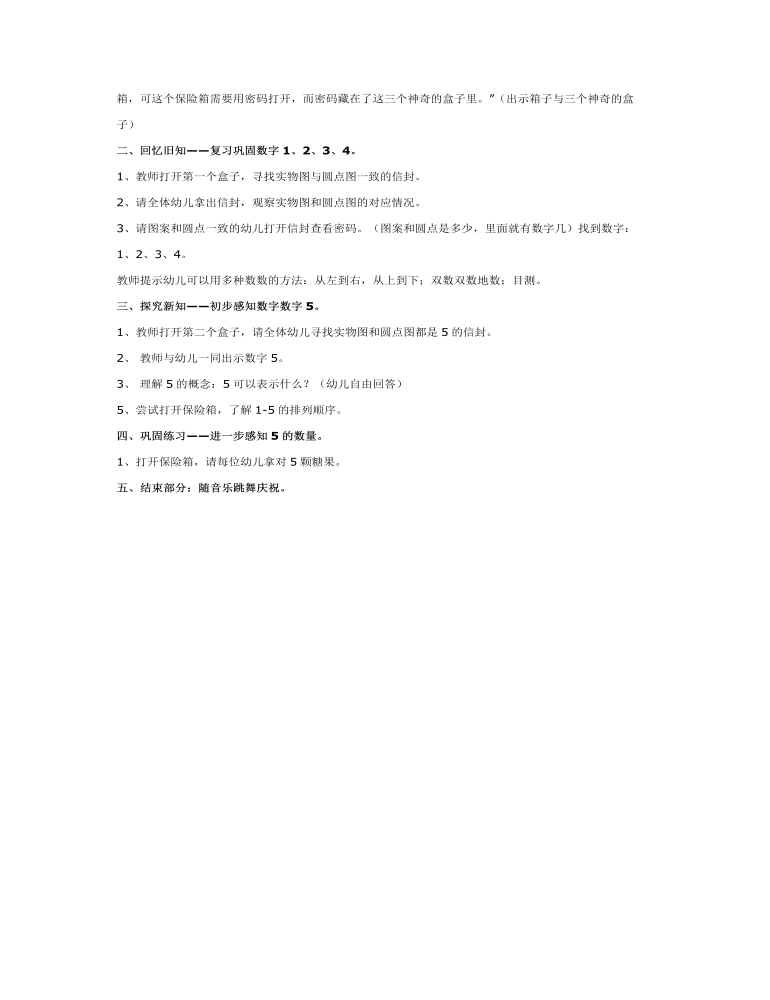
中班数学教案:破译密码——感知数字5
教学目标:1、通过游戏活动,初步理解5的概念,认识数字5。2、初步感受用不同方法来数数,并能按照一定的顺序来排列数。3、激发幼儿学习数学的兴趣,体验成功的喜悦,培养合作的意识。教学重点:通过游戏活动,初步理解5的概念,认识数字5。教学难点:初步理解5的概念。教学准备:1、 自制保险箱一个,神奇的盒子3个。2、 在信封的正反两面分别贴有图案和圆点个数一致的和不一致的各若干个,5个信封当中装有数字1、2、3、4、5,其他都是小小的数字5。3、 若干个小箩筐和一个大箩筐,若干糖果。4、 机器猫胸饰一个,《机器猫》的主题曲。教学过程:一、创设情境,导入新课。师:“小朋友们,你们看,这是谁呀?(出示机器猫胸饰贴在黑板上)原来是机器猫小叮当。今天它给我们小朋友出了个难题,这儿有个漂亮的保险箱,里面装着许多好东西,它让我们来想办法打开这个保险箱,可这个保险箱需要用密码打开,而密码藏在了这三个神奇的盒子里。”(出示箱子与三个神奇的盒子)
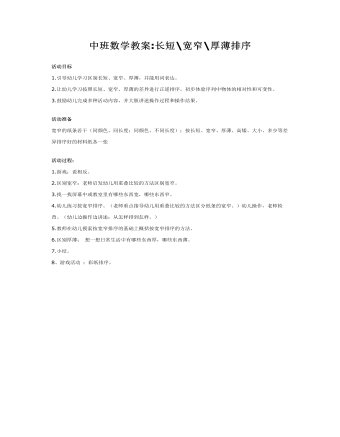
中班数学教案:长短宽窄厚薄排序
2.让幼儿学习按照长短、宽窄、厚薄的差异进行正逆排序,初步体验序列中物体的相对性和可变性。 3.鼓励幼儿完成多种活动内容,并大胆讲述操作过程和操作结果。活动准备 宽窄的纸条若干(同颜色、同长度;同颜色、不同长度);按长短、宽窄、厚薄、高矮、大小、多少等差异排序好的材料纸各一张

